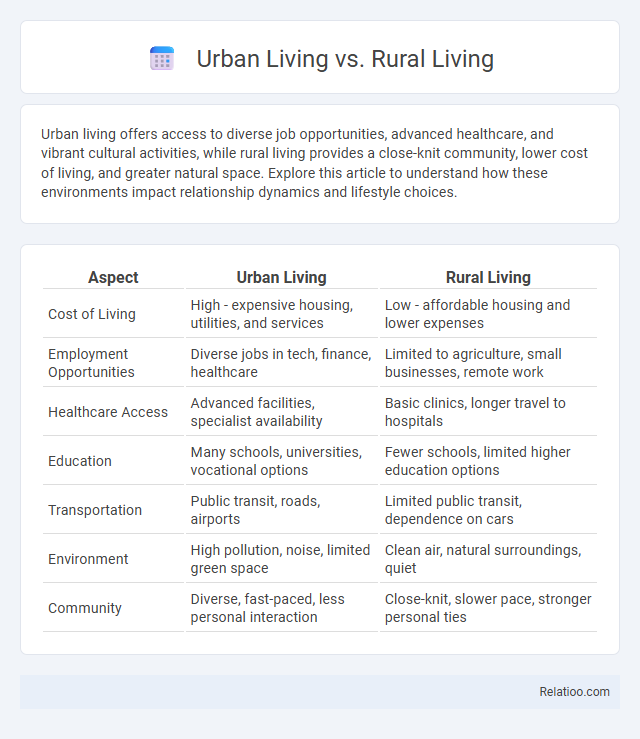Urban living offers access to diverse job opportunities, advanced healthcare, and vibrant cultural activities, while rural living provides a close-knit community, lower cost of living, and greater natural space. Explore this article to understand how these environments impact relationship dynamics and lifestyle choices.
Table of Comparison
| Aspect | Urban Living | Rural Living |
|---|---|---|
| Cost of Living | High - expensive housing, utilities, and services | Low - affordable housing and lower expenses |
| Employment Opportunities | Diverse jobs in tech, finance, healthcare | Limited to agriculture, small businesses, remote work |
| Healthcare Access | Advanced facilities, specialist availability | Basic clinics, longer travel to hospitals |
| Education | Many schools, universities, vocational options | Fewer schools, limited higher education options |
| Transportation | Public transit, roads, airports | Limited public transit, dependence on cars |
| Environment | High pollution, noise, limited green space | Clean air, natural surroundings, quiet |
| Community | Diverse, fast-paced, less personal interaction | Close-knit, slower pace, stronger personal ties |
Introduction to Urban and Rural Living
Urban living features dense populations, advanced infrastructure, and access to diverse amenities including healthcare, education, and entertainment, supporting fast-paced lifestyles. Rural living offers spacious environments with closer connections to nature, agricultural opportunities, and lower living costs, often emphasizing community and slower daily rhythms. Lifestyle changes between these settings impact health, social interactions, and economic prospects due to contrasting environmental and cultural factors.
Demographics and Population Density
Urban living typically features high population density with diverse demographics, fostering fast-paced lifestyles and extensive access to amenities. Rural living offers lower population density and a more homogeneous population, emphasizing close community ties and slower, nature-oriented lifestyles. Lifestyle changes often involve migration from rural to urban areas, driven by employment opportunities, education, and access to healthcare, reshaping demographic patterns and increasing urban population density.
Housing and Cost of Living
Urban living offers diverse housing options such as apartments and condos but typically comes with higher rent and property prices that impact your overall cost of living. Rural living provides more affordable housing with larger spaces and lower property taxes, though limited access to amenities can influence lifestyle preferences. Lifestyle changes often depend on prioritizing either the cost-efficiency and tranquility of rural areas or the convenience and dynamic environment found in urban settings.
Employment Opportunities
Urban living offers diversified employment opportunities across industries such as technology, finance, and healthcare, attracting professionals seeking career growth and higher income. Rural living often provides limited job options primarily in agriculture, small businesses, or local services, which may lead individuals to consider lifestyle changes for better economic prospects. Your decision to transition between these environments significantly impacts access to job markets, professional networking, and long-term career development.
Transportation and Infrastructure
Urban living offers extensive public transportation networks, including subways, buses, and bike-sharing systems, facilitating efficient mobility and reduced reliance on personal vehicles. Rural living typically depends on private cars due to limited public transit options, often resulting in longer commute times and challenges accessing infrastructure like healthcare and education. Lifestyle change from rural to urban environments demands adaptation to faster-paced transit systems and densely built infrastructure, impacting daily routines and accessibility.
Access to Education and Healthcare
Access to education and healthcare in urban living typically surpasses rural areas, with cities offering more diverse schools, universities, and specialized medical facilities. Rural living may provide fewer educational institutions and limited healthcare services, often requiring longer travel times and lower availability of specialists. Your lifestyle change from rural to urban can significantly enhance access to quality education and comprehensive healthcare, improving overall well-being and opportunities.
Social Life and Community Engagement
Urban living offers diverse social opportunities and vibrant community events that foster networking and cultural exchange, often in densely populated areas with numerous social venues. Rural living emphasizes close-knit communities and strong interpersonal bonds, promoting active participation in local traditions and communal support systems despite fewer entertainment options. Lifestyle changes between these environments impact social life and community engagement by shifting daily interactions, accessibility to social resources, and the scale of community involvement, influencing overall well-being and social fulfillment.
Environmental Impact and Sustainability
Urban living often results in higher carbon emissions due to dense traffic and energy consumption, while rural living typically promotes lower environmental footprints through access to natural resources and sustainable practices. Your lifestyle change towards eco-friendly habits can significantly influence sustainability by reducing waste, conserving water, and adopting renewable energy regardless of your location. Emphasizing green spaces and sustainable infrastructure in both environments supports long-term ecological balance and community health.
Lifestyle, Culture, and Recreation
Urban living offers a fast-paced lifestyle with access to diverse cultural events, restaurants, and recreational facilities, making it ideal for those seeking dynamic social experiences. Rural living emphasizes a slower, nature-oriented lifestyle, featuring close-knit communities and outdoor activities like hiking and farming, which can promote mental well-being and physical health. Your lifestyle change will depend on whether you prioritize cultural vibrancy and varied entertainment or peaceful surroundings and nature-based recreation.
Pros, Cons, and Choosing the Right Fit
Urban living offers access to diverse job opportunities, cultural amenities, and public transportation, but it may involve higher living costs and noise pollution. Rural living provides a quieter environment, closer connection to nature, and lower housing expenses, though it often lacks access to healthcare facilities and social activities. You should weigh these pros and cons carefully to choose the lifestyle that best aligns with your priorities and long-term goals.

Infographic: Urban Living vs Rural Living
 relatioo.com
relatioo.com